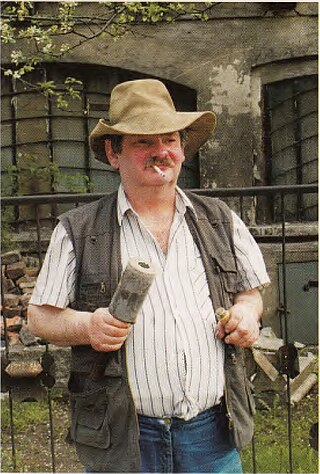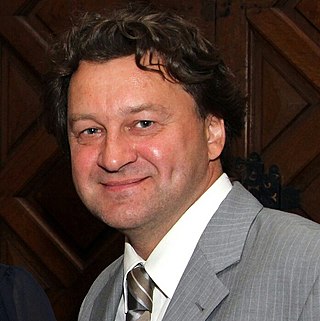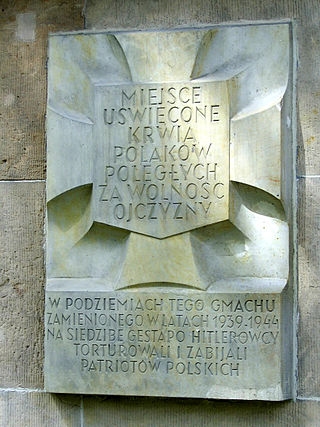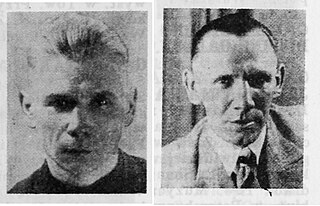
Xawery Dunikowski was a Polish sculptor and artist, notable for surviving Auschwitz concentration camp, and best known for his Neo-Romantic sculptures and Auschwitz-inspired art.

Krzysztof Michał Bednarski (KMB) is a contemporary Polish-Italian sculptor.

Mieczysław Jan Ireneusz Lubelski was a Polish monumental sculptor and ceramicist. In Poland he was part of the Poznań-based art movement, Świt, (Dawn). He was the author of many public sculptures and monuments, as well as of Religious art in several Polish cities, many of which did not survive the war. A Holocaust survivor, he was hidden by Catholic clergy in Kielce, took part in the Warsaw Uprising and after captivity in a German POW camp, resumed the final years of his career in the United Kingdom. After World War II he became especially known for the Polish Air Force Memorial in Northolt, and for reinstating some of his shattered work in Communist Poland. He also took on interior ceramic designs for exiled Poles in London.

Czesław Dźwigaj is a Polish artist, sculptor, and professor. Creator of numerous monuments, he is most often associated with monuments of Pope John Paul II, almost 50 of which have left his workshop.

Józef Jan Gosławski was a Polish sculptor and medallic artist. He was a designer of coins, monuments and medals. Laureate of many artistic competitions; decorated with the Silver Cross of Merit.

Barbara Zbrożyna (1923–1995) was a Polish sculptor, creator of figural sculptures, monuments, portraits, religious and sepulchral sculptures. Her style evolved from realism through the synthetic simplifications, expressive and metaphoric deformation, to abstraction. She was also a painter, drawer and poet. Awarded for achievements in arts by Solidarność, awarded the Prize of Brat Albert Chmielowski (1986) and Prize of Polcul Foundation (1991).

Stanisław Jackowski was a Polish sculptor, and nephew of novelist Bolesław Prus. In 1909-11 Jackowski studied sculpture at the Academy of Fine Arts in Kraków under Konstanty Laszczka, as well as the history of art at Kraków University. In 1911-12 he attended the Académie Colarossi in Paris, France.

Dorota Dziekiewicz-Pilich is a Polish sculptor and drawing artist.

Konstanty Laszczka was a Polish sculptor, painter, graphic artist, as well as professor and rector of the Jan Matejko Academy of Fine Arts in Kraków. Laszczka became the Rector of the Academy in 1911, however, for family reasons he resigned from this function in 1912.

Wiesław Adamski was a Polish sculptor. He was born in Wierzchowo.
Edward Łazikowski is a Polish artist whose work includes drawing, painting, photography, sculpture, installation art, performance art and art theory.

Giennadij Jerszow is a Polish–Ukrainian sculptor, jewelry designer and art teacher. He is a member of the National Union of Artists of Ukraine, and the National Association of Polish Artists and Designers. He is known for the production of monumental works, easel compositions and portraits, represented in different countries.

Tchorek plaques are a common design of memorial plaque in Warsaw, Poland, used to commemorate places where battles or executions took place during the German occupation of the city during World War II. They are based on an original design by sculptor Karol Tchorek from 1949.

The Polish Cavalry Monument, also known as the Millennium Polish Cavalry Monument, is a statue located at the Polish Cavalry Roundabout in Warsaw.

The Prince Józef Poniatowski Monument in Warsaw is a monument currently located at 46/48 Krakowskie Przedmieście in the courtyard of the Presidential Palace. Created by Rome-based Danish sculptor Bertel Thorvaldsen in 1829, it depicts Józef Poniatowski (1763–1813) riding and horse and dressed as Roman general.

Magdalena Więcek (July 23, 1924 in Katowice, Poland - December 31, 2008 in Dahab, Egypt) was a Polish sculptor and art teacher.
Zygmunt Świechowski was a Polish art historian and architectural conservator with a particular interest in the Romanesque era. Świechowski was also a leading figure in architectural preservation and restoration work in Poland, and he used photography extensively to illustrate his books as well as in a number of public exhibitions. His best-known work is Romanesque Art in Poland, with 28 editions published between 1982 and 1990 in six languages.

Stanisław Horno-Popławski (1902-1997) was a Russian-Polish painter, sculptor and pedagogue.

Brothers Teodor and Franciszek Gajewski were sculptors and painters, who lived in Bydgoszcz, Poland in the 20th century.
Bronisław Kłobucki (1896–1944), was a Polish sculptor and painter whose works are associated with Bydgoszcz and its region.
























